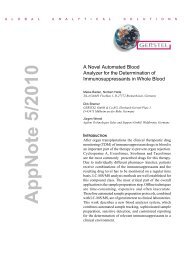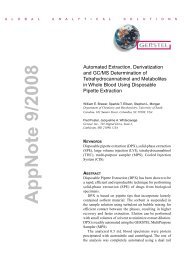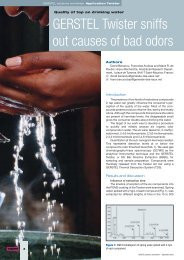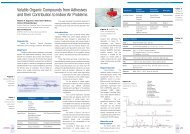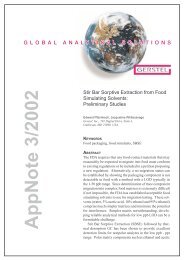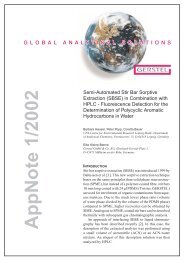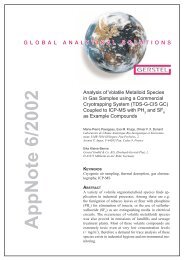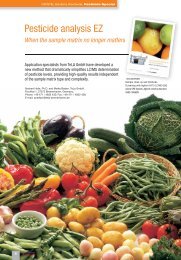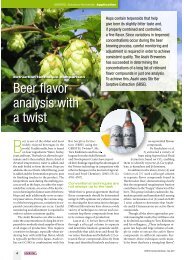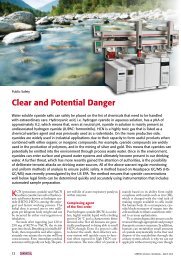GERSTEL Solutions No. 7 (pdf; 1,86 MB)
GERSTEL Solutions No. 7 (pdf; 1,86 MB)
GERSTEL Solutions No. 7 (pdf; 1,86 MB)
You also want an ePaper? Increase the reach of your titles
YUMPU automatically turns print PDFs into web optimized ePapers that Google loves.
<strong>GERSTEL</strong> <strong>Solutions</strong> Worldwide Report<br />
To perfect the composition of a wine, scientists start<br />
by separating the score of flavors into single notes.<br />
In their quest for a bouquet of fragrant high notes,<br />
scientists at the Research Institute Geisenheim rely<br />
on some rather unusual methods.<br />
Lab on the slopes<br />
Flavor from trash cans<br />
In a German vineyard, scientists of the Research<br />
Institute of Geisenheim practice an<br />
unusual, but very sophisticated type of viticulture<br />
using hundreds of trash cans. The<br />
Geisenheim wine researchers are systematically<br />
pursuing the lofty goal of creating perfectly<br />
balanced wine. They must follow an intricate<br />
path so that factors which could influence<br />
the taste or cause off-odor is addressed<br />
in the vineyard, not in the cellar.<br />
ficial quality inspection: „We want to find<br />
out why lately, in some German white wines<br />
such as Riesling, Kerner and Müller-Thurgau<br />
an off-odor develops with increasing<br />
age” explains Prof. Otmar Löhnertz.<br />
The expert oenologist explains that the<br />
trash cans are used to better observe the<br />
complicated wine system and to influence<br />
the development of plants and grapes by<br />
changing various parameters.<br />
“In the trash cans, we investigate the development<br />
of the vines by specifically varying<br />
the intensity of sunlight, the supply of<br />
nutrients and the precipitation”, says Prof.<br />
Löhnertz. „We now strongly suspect that<br />
climatic stress is the cause of UTA.“<br />
A plant is stressed by factors such as<br />
strong UV radiation, high temperatures<br />
like those experienced in Europe in the<br />
summer of 2003, and by a shortage of nutrients<br />
in the soil. The undesirable flavor<br />
that can originate from stress conditions is<br />
formed by young wine just a few months<br />
after fermentation. In small doses, 1-AAP<br />
»We suspect that<br />
climatic stress is<br />
the cause of the<br />
atypical aging<br />
(UTA) off-odor.«<br />
Prof. Otmar Löhnertz,<br />
Research Institute<br />
Geisenheim<br />
Searching for off-odors<br />
A white wine contains 800 to 1000 different<br />
taste and flavor components, a red<br />
wine even more. In their laboratories, the<br />
Geisenheim scientists try to break down the<br />
flavor into its individual components. Most<br />
recently, they identified „atypical aging flavor“<br />
(UTA), which is caused by the presence<br />
of 2-aminoacetophenone (2-AAP). Wines<br />
containing 2-AAP are flat and appear excessively<br />
aged with a distinct fragrance note<br />
of mothballs. It has been due to the 2-AAP<br />
that some Riesling wines didn’t pass the ofis<br />
a pleasant flavor with a fruity note. Increase<br />
the dose, however, and the unpleasant<br />
“mothball” odor comes to the forefront.<br />
The “aging” flavor is not only found in German<br />
vineyards, this research will apply to all<br />
wines that have problems with UTA.<br />
<strong>No</strong>t every grape variety is<br />
right for every vineyard<br />
From a scientific point of view, wine quality<br />
depends mainly on two initial factors:<br />
12<br />
<strong>GERSTEL</strong> <strong>Solutions</strong> Worldwide – May 2007



